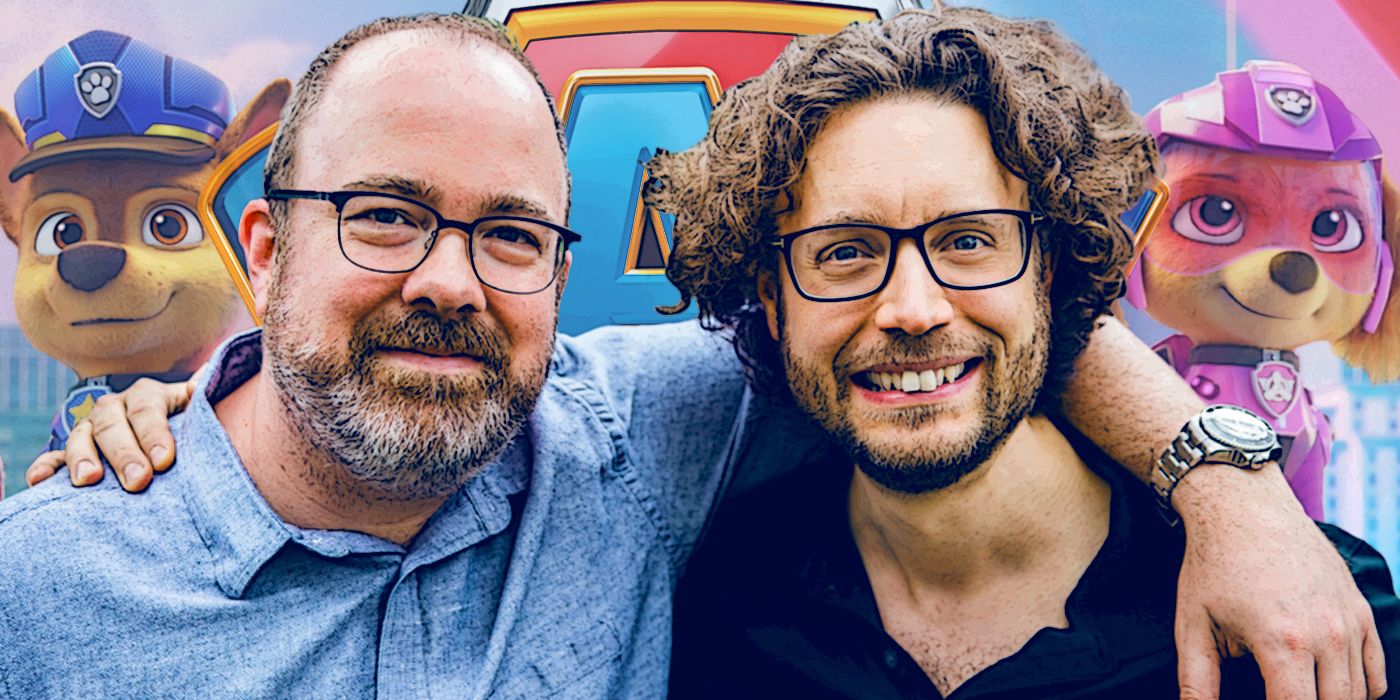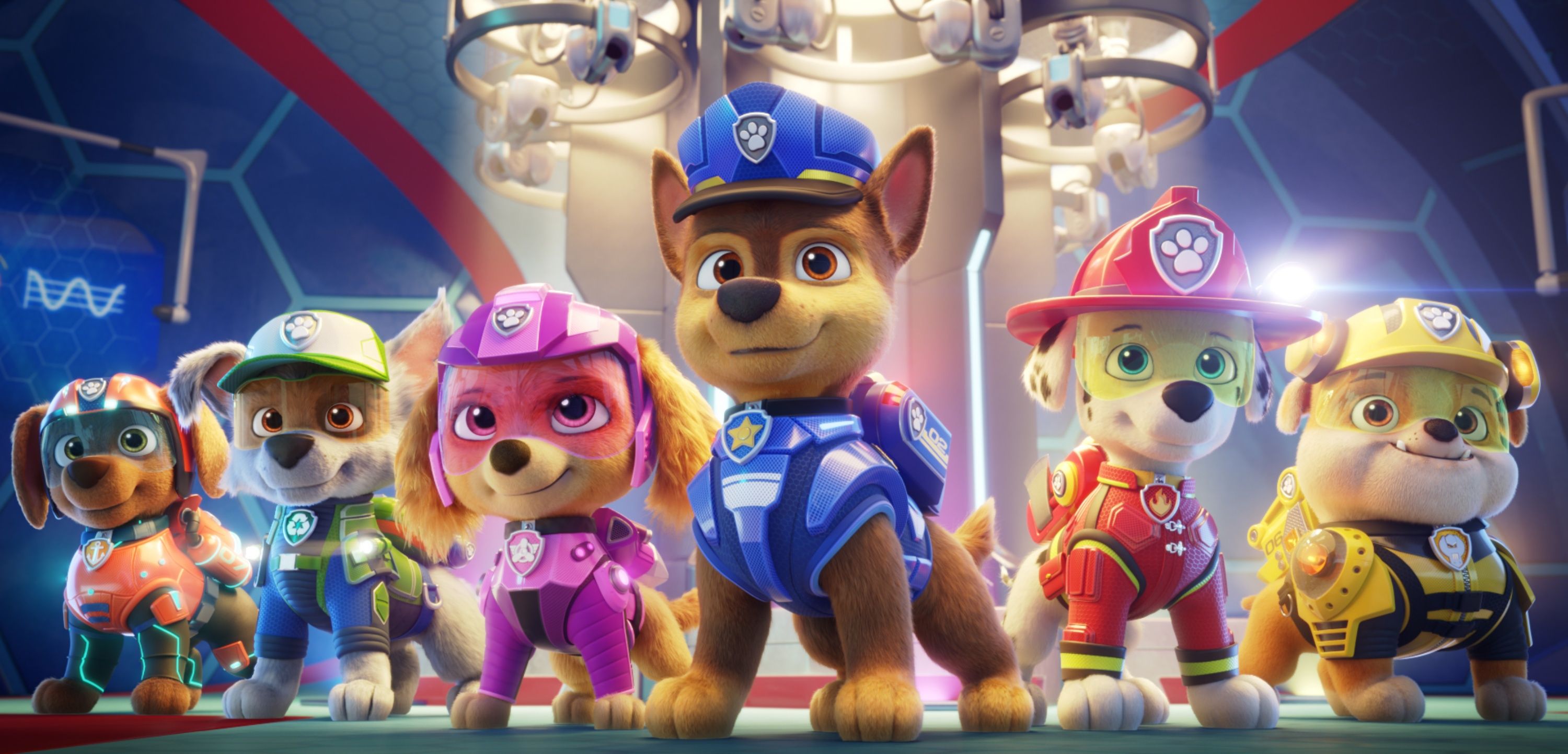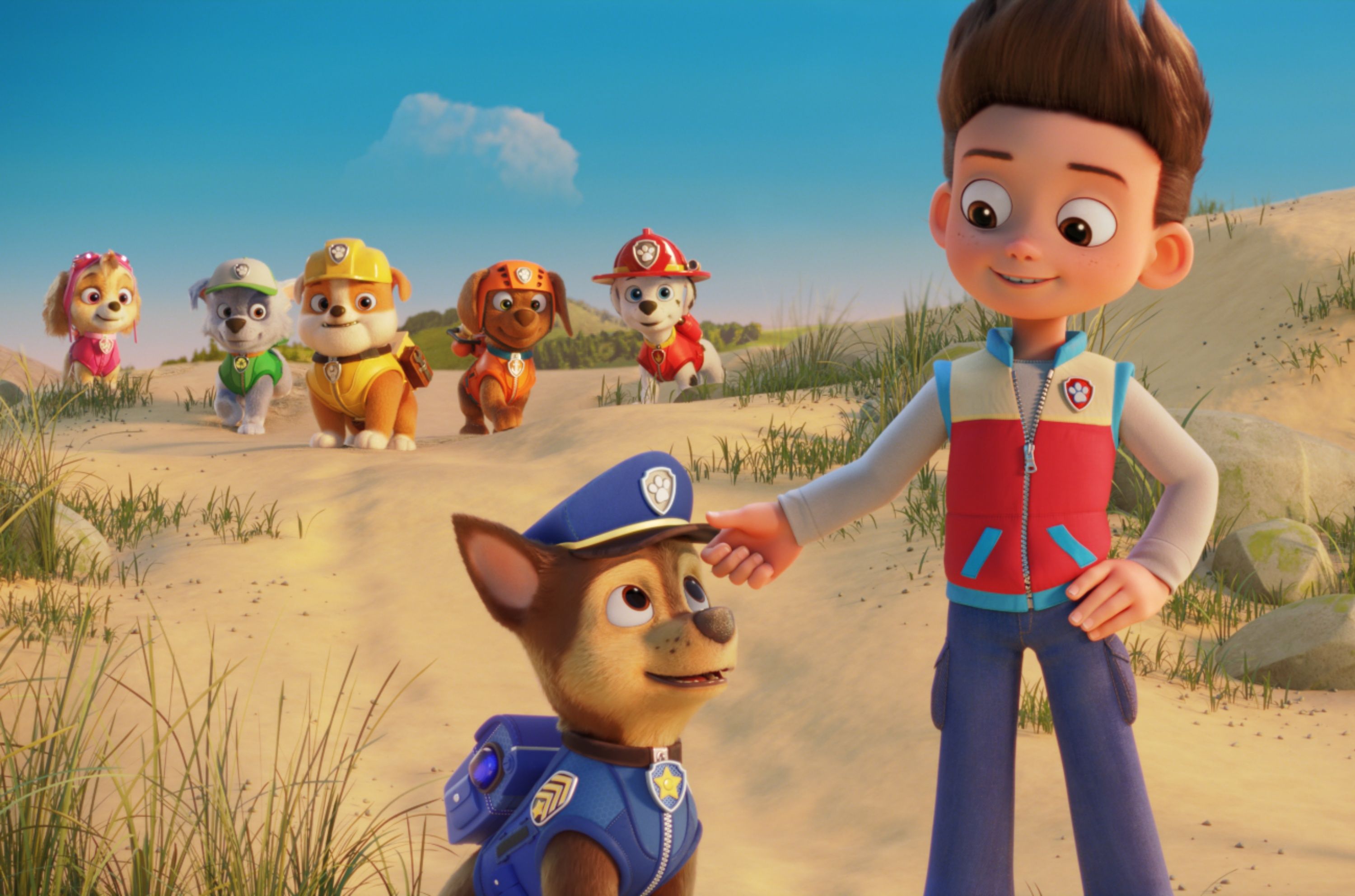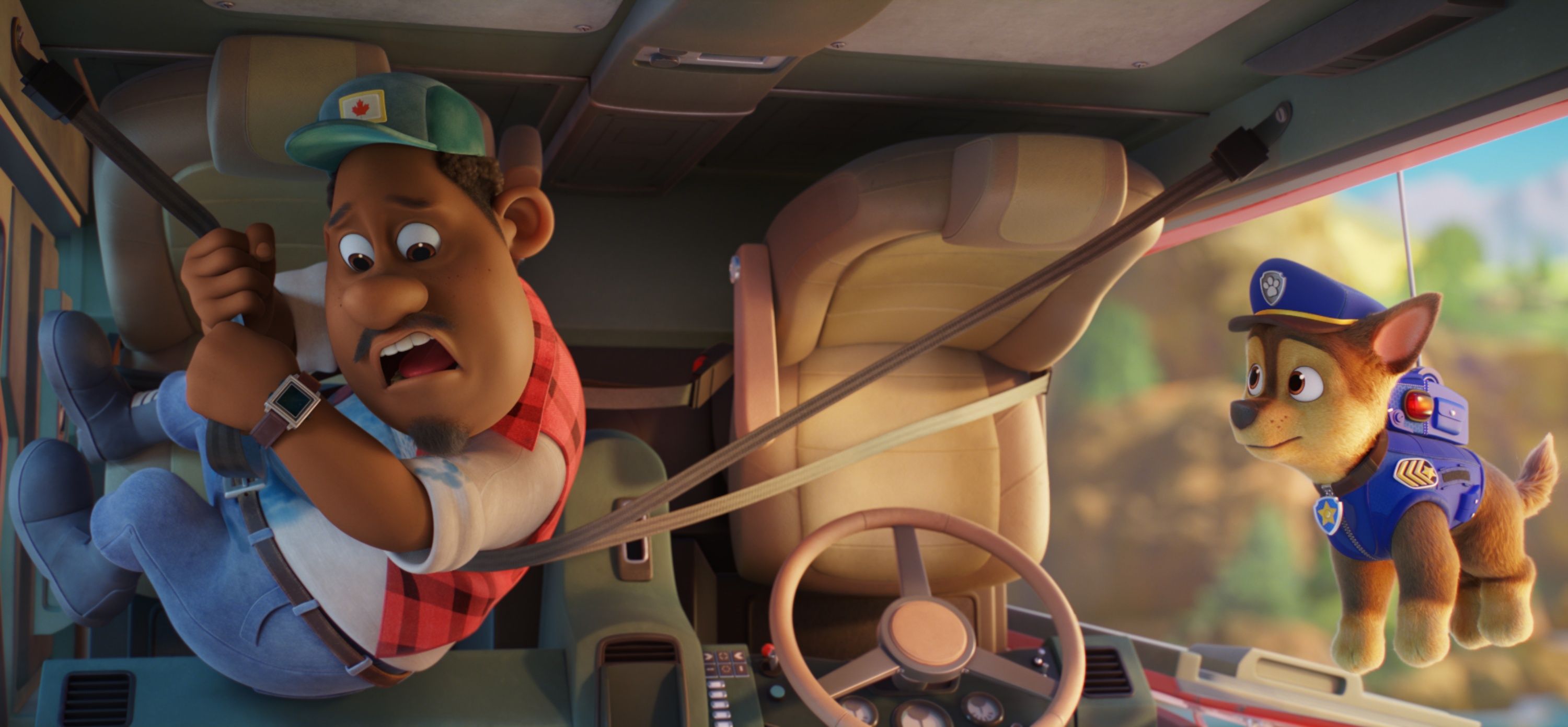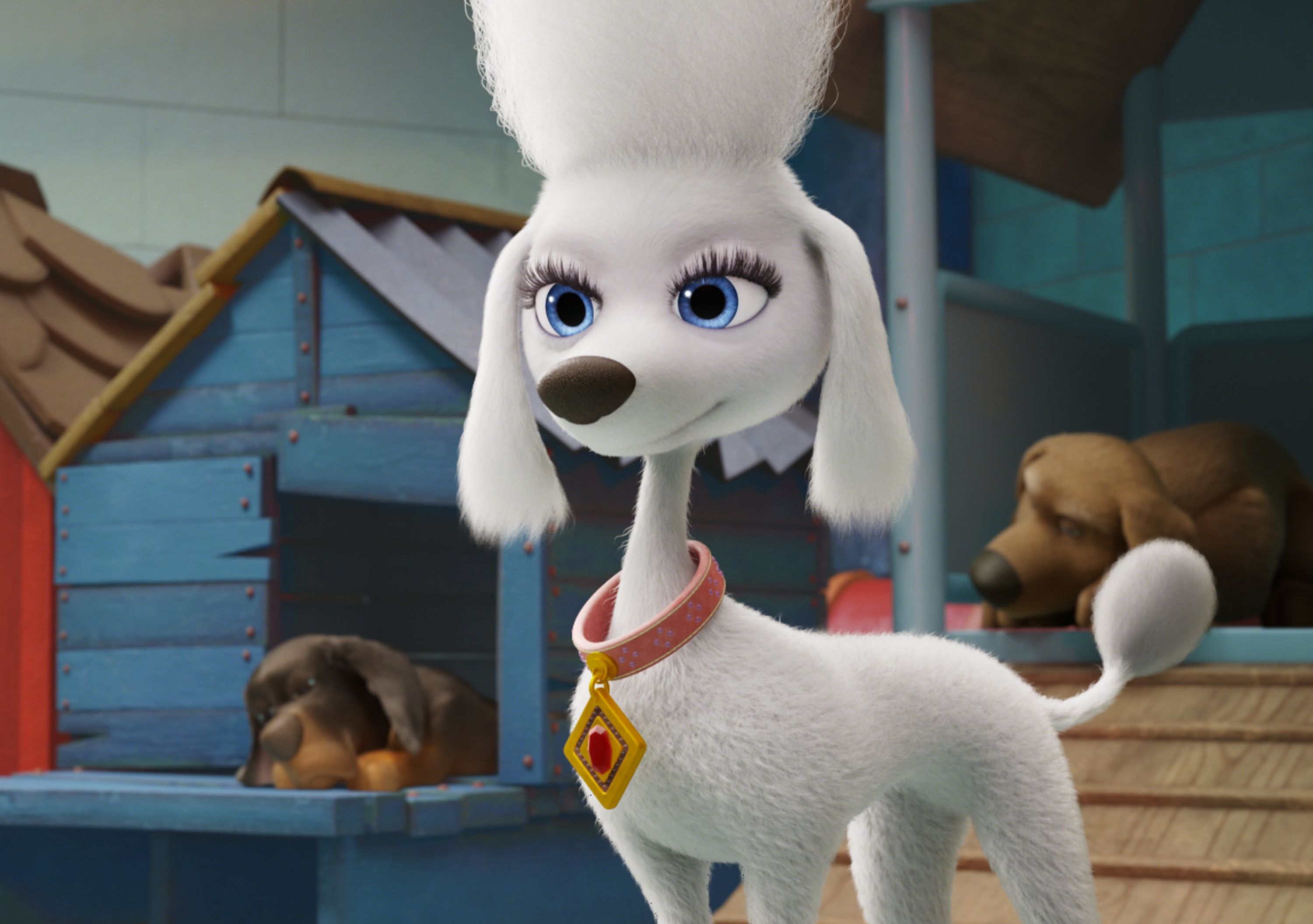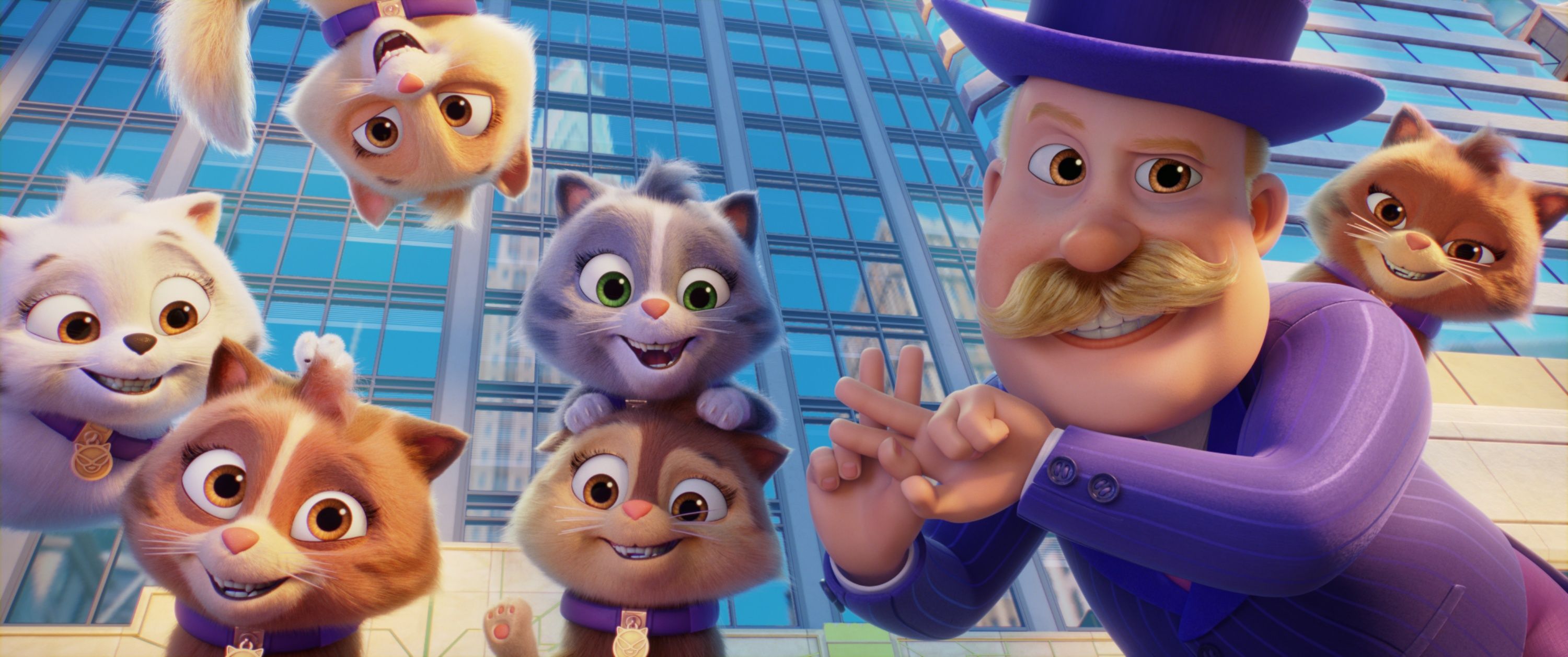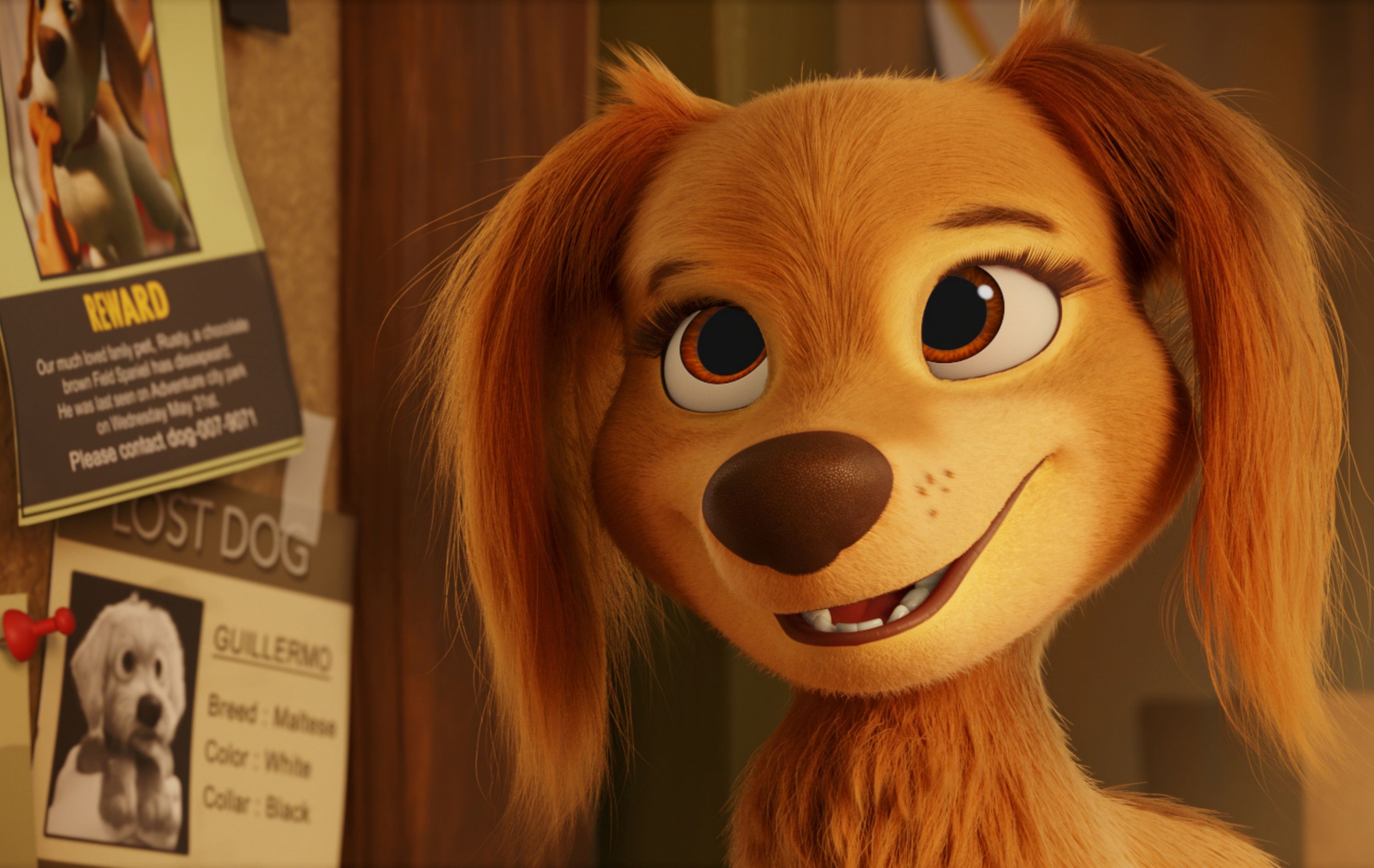From director Cal Brunker, who also co-wrote the film with Bob Barlen and Billy Frolick, the animated feature PAW Patrol: The Movie follows Ryder and everyone’s favorite heroic pups from the hit Nickelodeon series, as they face off with heir biggest rival and fight to save the citizens of the metropolis known as Adventure City. With new gadgets, gear and ultra cool vehicles, German Shepherd police dog Chase, Dalmation firedog Marshall, Cockapoo aviator Skye, construction Bulldog Rubble, mixed breed Rocky who can put any tool to good use, Labrador water rescuer Zuma, and their new pal and local miniature Dachshund Liberty must band together and overcome their own fears, in order to successfully complete their mission.
During this interview with Collider, Brunker and Barlen talked about telling a story that satisfies longtime fans of PAW Patrol while also bringing in a new audience, what makes the pups such lovable characters, getting to bring in a new pup, the process for developing the merchandise, the fun in working with this voice cast, which longtime question they finally provide an answer for, whether they’d like to make more PAW Patrol films, and what they love most about working in animation.
Collider: One of the things that I was really impressed about with this is that you are taking something that people are familiar with, and there’s a big fan base for this world and these characters, and you’re telling a story that’s not too repetitive for fans, but still accessible for people who aren’t familiar with it. How did you manage that?
CAL BRUNKER: I’ve got two young kids, six and three years old, so PAW Patrol was a staple at our house.
BOB BARLEN: I have five nieces and nephews that are all in the PAW Patrol range. We were both familiar with it, definitely. But in terms of actually then adapting it into a film, we had to dive a little deeper.
BRUNKER: One of the things is that, at the very beginning of the movie, the first rescue that takes place, that character has never heard of the PAW Patrol before and is shocked to see a puppy show up to save him. That was our way of trying to start the movie in an inviting way for people who maybe didn’t know anything about the show. It says, “Yeah, it’s weird that dogs are doing this, but that’s okay.” And then, you’ll have a laugh and come along for the ride. We wanted to address that, up front, for people who hadn’t seen it.
What made now the right time for a PAW Patrol movie and how has there not been a movie before now?
BRUNKER: I don’t want to speak too much for Spin Master because this is our first time working with them, but I think they were just trying to get it right. They knew that if they came to the big screen, they wanted it to be something that fans would love and was something that felt it deserved a trip to the movie theater to see it on the big screen. I think they just waited until they felt they had the right idea and the right team in place to bring something forward.
At the same time, this is known as a preschool property and I’m guessing you wanted to widen the audience with this film. How did you weigh just how scary you wanted things to get, especially knowing that you would have a young audience, but you would also want to bring in an older audience?
BRUNKER: That that was our constant discussion on this movie. You nailed it, in terms of going, “We want this to be as exciting as possible for the most number of people without scaring our youngest audience.” Pretty early on, we started showing the movie to young kids to gauge they were. The feedback we got, we were much more nervous about it then the kids were. A lot of kids these days, even very young, are watching what older siblings are watching, whether that’s Marvel or whatever else is going on. And so, the feedback we got is that they their attention was rapt and they were just totally into it, and we saw where we could push. One of the tools that we found early that worked well is that you can be intense for a little while, but then you’ve gotta let the pressure off with a joke or something. Just don’t stay too intense for too long. That seemed to be the trick.
BARLEN: When we were planning it out, and when we were writing and storyboarding, our goal was always to know that, as a preschool property, this had a very dedicated core group, but those kids don’t often go to the theaters, or if they do, this will be their first movie. And so, it was our creative challenge to expand the world to make the film something that would play for the older brother and the older sister and a larger range.
BRUNKER: We wanted there to be something for the parents and for it to be a whole family film.
BARLEN: Exactly. We wanted it to be something that is not limited. The show is for the younger crowd, whereas hopefully with the movie, we were able to expand it for a wider audience.
When you started having conversations about what this could be, were you given any guidelines or a list of things to do and not do with the property overall, or was it wide open, as far as figuring out the size and the scope of the story you wanted to tell? What was the key to all of that for you?
BRUNKER: Our partnership with Spin Master and the team at Nickelodeon has been amazing. They were really game-on for us to push. They would occasionally be the guard rail to go, “I think you’re getting a little bit too far off what people are used to,” but they were wonderful partners. The nice thing about animation is that we could do it in storyboards and show them, “Hey, we’re thinking of doing something like this.” That was a wonderful way for them to be able to go, “Okay, we’re comfortable with that. Keep pushing.” It wasn’t limited. It was really, really supportive. Everybody wanted to make the feature film version of PAW Patrol something familiar, but something new and worth going to the theater for, so there was an appetite to push the limits on it.
Was there anything you were surprised that you were able to do?
BRUNKER: Without giving away the joke, one of the questions from parents always is, “How does the PAW Patrol pay for all these things? They have towers and vehicles and gadgets. Who’s bankrolling this thing?” And so, we answered that question in the movie with a joke, and we didn’t think our partners would let us keep that in, but they loved it. They thought it was hilarious. They’ve got a good sense of humor about the whole thing. Without saying what that is, you can find out, if you watch the movie, how they bankroll all of their gear.
What do you think it is about these characters that makes them so appealing and so lovable for audiences, all these years?
BRUNKER: The pups always do the right thing and the stories and the whole world is not cynical at all. It’s really inviting. There’s not a ton of stuff like that. Also for the younger kids, I think there’s a really clear delineation between right and wrong, which helps them get into the stories at an early age. And in terms of resonating with an older audience, I think our approach was to try to tell a deeper emotional story with several of the characters throughout the film and they’re universal things that these characters are going through, even if they’re pups in this case. That’s something that I think the audience can understand as metaphor for stuff they might be going through in their own life or that their kids are going through, or whatever.
What’s it like to add a new pup to that and figure out who that new pup should be and who would be deserving of being a new PAW Patrol member?
BARLEN: For us, in terms of actually creating Liberty, it was really fun because one of the nice things was that we were able to create a character that maybe was a bit different than the other pups. All the pups in the PAW Patrol are perfect and they’re great. They’re a certain way, but Liberty has got a little bit of an edge to her, which is nice. Having her experience and seeing her experiencing the film from her point of view, as she relates to the PAW Patrol, is really fun. And then, in terms of Marsai Martin who plays her, she’s such an incredible actress. It was such a gift that she agreed to do it because she really brings the character to life. We couldn’t imagine her being played in a better way by a better character, so we were really looking to have her on.
BRUNKER: We found that because she’s a new character, it allowed us to write quite differently for her than the other pups. Since she grew up in the city, it justifies her having a little bit thicker skin and a tougher way of talking. It was fun to juxtapose that with the attitudes that people are used to from the regular core team of pups.
How much fun is it to create new uniforms, new gadgets, and new vehicles for these pups, and then to see how all of that would ultimately look? Do you just feel like a big kid when you get to do something like that?
BRUNKER: We’re huge fans of toys and we’ve got stuff all over our shelves in our office, and we got to work with the engineers. We would come up with something for the story and we’d be like, “Is this something you could actually physically build? Chase’s car does some pretty wild stuff.” And the engineers of figured out how to do all that and make that happen in the toys. For us, it was wonderful because we’re trying to tell this story and design these new gadgets and have these really exciting visuals, and at the same time, there are people in the real world, really physically building these things, and we would take their physical models and look at them. The CG artists would check them out from different angles and see how to make it work. It was a really wonderful, tactile way of developing because they’re real. A lot of movies we’ve done before, stuff just exists in the computer, but because there’s an additional toy side of things, a lot of that stuff really got built and it was a thrill to get to hold and touch these vehicles and gadgets. That really brought the film to life in a tactile way for us that isn’t always the case in CG.
Do you have a favorite toy for the movie?
BRUNKER: For me, it’s Chase’s cruiser. My son brings it to bed with him now, he loves it so much. It’s got a motorcycle that shoots out of it and an armor mode. It’s amazing. And then, there’s the tower. That was one of the things for us, from the very beginning, where we went, “How can we really build up the anticipation to this moment, where they’re driving out into the city? Wouldn’t it be great, if we had this ramp coming out of the tower, but so big that it was like driving a car down a ski hill? Can we work at that scale?” In the movie, it’s just awesome to see that thing unfold for the first time.
BARLEN: For me, I would say definitely the cruiser. When the toy designers and engineers actually showed us the first prototype, they came to the offices and brought it in and they were unpacking it. I said, “Oh, boy, I can’t wait to play with us.” And they said, “This is extremely expensive, don’t touch it.”
BRUNKER: It was a single, 3D-printed, hand-painted only one in the world. They flew with it on their laps. You can’t check that or mail it. It was a single prototype.
BARLEN: So, I waited until we got a few more into production, before I actually got my playtime in.
Is there a member of the PAW Patrol that you personally feel most connected to?
BARLEN: For me, I would definitely say it’s Liberty, only because she is not afraid to speak up and speak her mind. That’s a really valuable thing to do, to just be honest like that, but also the way that she is, I can relate a lot to that.
BRUNKER: For me, I’ve certainly got a soft spot for Liberty because we had a chance to create her from nothing and help, along with Marsai and our team, bring her to life. But in terms of from a writing standpoint, I like writing Rubble the best. I think he’s the funniest. He’s just a little bit late to the party on everything. All the other pups are pretty on top of it, and he’s usually slow on the uptake, but he’s really lovable and he’s got this great heart. We found that we were writing a lot of comedy for Rubble. That’s one thing where our partners were like, “You guys are writing too many jokes for Rubble. Share the wealth.” And we were like, “Okay, okay.” But he’s a go-to for us, for sure.
You talked about working with my Marsai Martin specifically, but what did you enjoy most about working with this voice cast overall? How did they most surprise or impress you? Did any one of them improvise more than the others?
BRUNKER: The core cast of pups and Ryder are all kids, and that was new for us and really wonderful. We really worked with them to try to get true, meaningful performances out of all the characters, and I thought they did an amazing job. The character of Chase, played by Iain [Armitage], goes on such a wonderful emotional journey that’s a little bit unexpected, and he just brought so much to it. He broke our hearts in some moments. You really end up rooting for him. In terms of improvisation, I would say Marsai’s deliveries were the things that were most surprising. She almost couldn’t do anything bad. When we were going through the takes, it was like, “This is great. This is great in a different way. And this is great in a different way.” She was wonderful and brought so much energy to it. Everybody was wonderful. Dax [Shepard] is the nicest guy, who was game on for everything. Tyler Perry was thrilled to be a part of it. His son is a big fan, and he certainly loves to improvise and do lots of takes. We couldn't have had a better cast or a better experience for recording them.
How did Kim Kardashian come to voice a character?
BRUNKER: A lot of our cast is people that have kids who are watching the PAW Patrol universe at home, and they’re very keen to be a part of it. Adam Levine (the singer of Maroon 5), who wrote an original song for us called “Good Mood,” has got young kids. Tyler has got a kid. The story of Tyler getting into this movie is that, when we called to ask him if he wanted to be in the PAW Patrol movie, he looked down at his son and said, “Should daddy be in the PAW Patrol movie?” These big stars have this massive soft spot for whatever their kids are into, and Kim was like that too. She’s got kids that are this age, and this was a chance for their mom to be in something that they loved, so it worked out great.
The design of her character also seems like the perfect character for her to voice. It has the right vibe.
BRUNKER: When she said yes, we knew we had to redesign that collar with some more bling on it. We had to bring her up a little bit. We had the character all designed, but we were thrilled when she agreed to do it and fancied the character up even more.
With animation, you’re typically dealing with actors being in different places when you’re recording, but because of COVID, you really had no choice in keeping everyone separate. What were the biggest challenges in having to do everything remotely?
BRUNKER: That was tricky. One of the great benefits of Bob and I writing the movies that we make is that we’re hearing it in our heads a certain way, very clearly, long before we go do the recording. That really helps, when you’re recording actors sometimes months apart or in different places. We’ve still got the rhythms of the script in our head, the way we heard it or read it out loud to each other. Of course, the actors bring a ton to it, but in terms of adjusting the nuance of exactly the level of conflict that two characters will have, or figuring out what the comedic timing will be, we hear those rhythms, so that helps us when we’re separate and the actors aren’t together, which is often the case. And then, in terms of working remotely, we had 250 artists that were working from home on this, for over a year. It was very difficult for the first couple of weeks, but the studio, Mikros Animation in Montreal, really got their act together very quickly. They had all sorts of social events for the team, so people still got the comradery of working on an animated film. It became this wonderful little glimpse into everybody’s lives, seeing their kids or their cats or their toy collections in the background and you got to know each other in a way that was a little bit different than when you all go into an office together.
BARLEN: This is the first film that we’ve ever done like this, but the team really did pull together. There were one or two times that we had to go into the studio, and because everybody was working remotely and it was all very confidential, nobody has anything locally on their computer, so we walked through the empty studio and saw a hundred computers with all the mice being remotely operated by people. It was like a haunted studio with everyone working remotely, but all coming together on Zoom. It was really just a testament to the team that they were able to pull it off and that we have a movie in theaters now.
Was the ending of this film always the ending that you had for it, or did that evolve or change at all?
BRUNKER: For the main character’s story, we knew what it was when we started, but it’s almost like digging up a dinosaur skeleton. We had to keep refining it and getting down to the core simple idea under it. You get close, but you don’t quite lock in to it. That’s what develops over time. It’s not that it’s a completely new idea. Chase’s story certainly got refined, through the storyboard process. What we did find, that was a wonderful surprise, was with Liberty’s story. When we were writing it, Chase and Liberty’s stories felt like two different stories. But as we started to add the music and started to intercut things and saw it all working together, they felt more like one story with two different characters experiencing it. That was a wonderful surprise that we watched evolve.
BARLEN: Animation is always so great for that because it’s so iterative. We go through multiple drafts of the script, and then multiple rounds of storyboarding, and each new phase in the process just helps the movie come to life a bit more. As we watch it again and again, we get to experience it again and again, but also, as we see the new elements, it’s like we’re watching it for the first time. So then, if something is really working, we can just lean into it more. It’s a really wonderful process, in that manner.
Obviously, it would depend on audience demand, but this film is clearly open for sequels. Would you like to do more PAW Patrol films? Have you thought about or had any conversations about doing more?
BRUNKER: We’ve certainly thought about it. There are other stories that we would be excited about telling. But for us, it’s really about seeing if people love this one, and then taking it from there.
What’s next for you guys? Are you working on anything right now?
BRUNKER: We’re working on some new stuff that we’re very hopeful to be able to share with the world before too long.
What brought you both to animation and what keeps you interested in animation?
BRUNKER: For me, it started really young with drawing and being a visual thinker and expressing myself visually. The idea of being able to create almost anything you can imagine in animation is something that I find incredibly attractive. Even being able to change the environment, from a storytelling standpoint, you can be like, “I want that skyscraper a little bit closer,” and you can just move things. You have this control over the world that’s really liberating. For me, that’s part of it. An animator on this movie might be doing three and a half seconds of animation a week. They really fall in love with movement, at a very microscopic level. They think about what order the fingers unfold in when they open the hand and how to get an emotion across through the eyebrows, and all of these things. It makes you look at life in a really microscopic way and appreciate small things. I love telling stories in animation. I love live-action movies too, but for us, the creative freedom of the medium is part of the draw.
BARLEN: I agree. One of the nice things about animated movies, just from growing up on animated films and loving them well past when I was grown, is that it’s so many people coming together and being able to make a film on a large scale that goes out so wide across the world. One of the exciting things about being a filmmaker is that your work is seen by hundreds of thousands or millions of people. Animation allows us to work at a scale where we can do something spectacular and really special on screen.
BRUNKER: What I would add to that is, working with a beloved show like PAW Patrol, which is such a widely loved show, and bringing that to the big screen, was such a gift. It felt like the audience was waiting for it. Sometimes you do a movie, and then you have to explain to the world what it is and why they should see it. With this, it felt like as soon as the trailer came out, people were excited. You want your movie to get out and for as many people to see it and love it as possible. It was just wonderful to have an audience waiting for it.
PAW Patrol is in theaters and available to stream at Paramount+.

